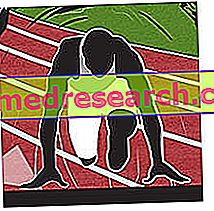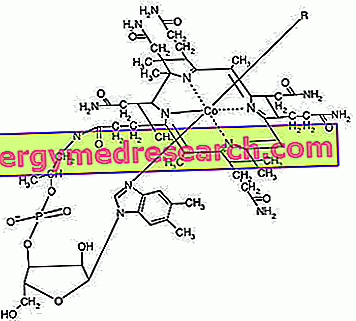Generality
Alcoholic heart disease is a heart disease that occurs due to excessive consumption of alcohol. From the medical point of view, it is included in the list of so-called dilatative cardiomyopathies.

As a rule, the diagnostic procedure for the identification of alcoholic heart disease includes: physical examination, medical history, RX-thorax, chest CT scan, echocardiogram and electrocardiogram.
The therapy focuses mainly on the immediate abolition of any alcoholic substance.
Brief review of what a cardiomyopathy is
The literal meaning of cardiomyopathy is: heart muscle disease.
Cardiomyopathies are particular cardiac diseases, which are characterized by an anatomical alteration of the myocardium (ie the heart muscle), such as to compromise the functioning of the latter.
A healthy myocardium is fundamental to guaranteeing the correct mechanism of action of the heart; therefore, a malfunctioning myocardium, like at the time of a cardiomyopathy, compromises the activity of the cardiac organ, sometimes drastically and with fatal results.
According to the most common classification, there are 4 different types of cardiomyopathies:
- Dilated cardiomyopathy ;
- Hypertrophic cardiomyopathy ;
- Restrictive cardiomyopathy ;
- Arrhythmogenic cardiomyopathy of the right ventricle .
The element that distinguishes these 4 types of heart disease is the alteration developed by the myocardium and responsible for the malfunctioning of the heart.

Figure (of the heart) : anatomy and blood circulation inside the heart.
The heart is an unequal organ, hollow and predominantly of a muscular nature (myocardium), which is placed inside the thoracic cage, on the left center.
Representing the most important organ of the circulatory system, the heart can be divided into two halves, the right half and the left half; in each half, two distinct cavities are recognizable, called the right atrium and right ventricle, with regard to the right cardiac half, and the left atrium and left ventricle, with regard to the left cardiac half.
Thanks to the activity of the cavities just mentioned, the heart first deals with oxygenating the blood in the lungs and then sending it to the various organs and tissues of the human body; specifically, the right atrium and right ventricle have the task of pumping blood into the lungs, while the left atrium and left ventricle have the important role of distributing blood to the organs and tissues of the whole body.
It is important to note that the flow of blood entering and leaving the various cardiac cavities is under the control of 4 valves, called heart valves.
What is alcoholic heart disease?
Alcoholic heart disease, more correctly called alcoholic cardiomyopathy, is a form of dilated cardiomyopathy due to prolonged abuse of alcohol .
Alcoholic heart disease is therefore a heart disease, included in the list of possible consequences of alcoholism .
What is dilated cardiomyopathy?
Dilated cardiomyopathy is a heart disease characterized by dilation of the left ventricular cavity and the consequent thinning of the muscular wall of this cavity.
In other words, in cases of dilated cardiomyopathy, there is an abnormal expansion of the left ventricle, followed by a reduction in the thickness of the myocardium constituting the aforementioned ventricle.
From such a situation, it appears that the heart finds several difficulties in pumping blood in circulation and in keeping the various organs and tissues of the human body healthy (NB: from the left ventricle comes the oxygenated blood destined for the various organs and tissues of the body).
Causes
As anticipated, the cause of alcoholic heart disease is the excessive consumption of alcohol for long periods of time. At cardiac level, in fact, prolonged alcohol abuse can determine the dilation and thinning of the muscular wall of the left ventricle, with obvious repercussions on the functionality of the latter.
Remembering that the left ventricle has the task of pumping the blood towards organs and tissues, its reduced functionality compromises the supply of oxygen to the aforementioned districts of the human body.
After how many years of alcoholism does alcoholic heart disease appear?
Several scientific studies have shown that individuals with alcoholic heart disease often have a history of alcoholism ranging between 5 and 15 years .
Note: when do you start talking about alcoholism?
Alcohol consumption is measured in alcoholic units .
An alcoholic unit corresponds to 12 grams of ethanol ; 12 grams of ethanol are contained, for example, in: a small glass (125 ml) of medium-strength wine, in a 330 ml can / bottle of medium-strength beer or in a small bar (40 ml) of a spirits .
We remind you that, for a healthy adult, the permitted Alcoholic Units (therefore not harmful to health) are two, for men under the age of 65, and one for women and men over the age of 65.
That being said, we start talking about alcoholism when:
- For men, alcohol consumption exceeds 4 Alcoholic Units per day or 14 Alcoholic Units per week;
- For women, alcohol consumption exceeds 3 Alcoholic Units per day and 7 Alcoholic Units per week.
Epidemiology
Most people with alcoholic heart disease are between 35 and 50 years old and are male, as the tendency to abuse alcohol for long periods of time is more common among men than among women; it should be pointed out, however, that, between a male alcoholic and a female alcoholic, the female alcoholic is more likely to develop alcoholic heart disease, as women have a greater difficulty in metabolizing alcohol than men hepatic.
Symptoms and complications
As a rule, alcoholic heart disease is responsible for symptoms and signs only in its most advanced stages, ie when heart health is already largely compromised; rarely, this condition is symptomatic (ie due to symptoms) right from the start.
Having said this, the possible manifestations of alcoholic heart disease are those typical of any dilated cardiomyopathy, that is:
- Persistent sense of tiredness and weakness;
- Dyspnea (shortness of breath or difficulty), both under stress ( dyspnea on exertion ) and at rest ( dyspnea at rest );
- Edema (swelling) in the legs, hips, feet, neck veins and abdomen (ascites);
- Syncope;
- Chest pain, which tends to get worse after meals;
- Irregular heartbeat;
- Accelerated beat (tachycardia);
- Presence of a particular heart murmur;
- Loss of appetite;
- Reduced ability to concentrate;
- Urinary problems, such as nocturia, oliguria, etc.
Alcoholic heart disease is a subtle disease
The absence of early symptoms (asymptomaticity) makes alcoholic heart disease a subtle disease, that is, that operates in the shadows with repercussions that are dangerous for the health of the human being.
Why is the disease asymptomatic in the beginning?
At the moment, doctors are still unable to explain why, at the beginning, alcoholic heart disease (and other dilated cardiomyopathies) are asymptomatic in the initial phase.
Complications
Alcoholic heart disease can degenerate into various complications, some of which are also very serious and with fatal results; here is what these complications could consist of:
- Heart failure . It is the medical term that indicates the presence of a heart now definitely incapable of fulfilling its functions; heart failure is an irretrievable condition that can only be resolved with a heart transplant ;
- Myocardial dilation and thinning extended to the left atrium and the right side of the heart;
- Valve regurgitation . It is the phenomenon that takes place when the heart valves, altered in the structure due to a change in the myocardium in this case, allow the blood to turn back, compared to where it started.
It should be remembered that, under normal conditions, heart valves allow blood transit in one direction only;
- Cardiac arrest . It is when the heart suddenly stops carrying out its pumping activity;
- Pulmonary embolism . It is when, inside the pulmonary arteries or one of their branches, there is an obstacle that prevents the correct flow of blood to the lungs;
- Worsening of arrhythmias already present.
When should I go to the doctor?
The presence in those who are at risk of alcoholic heart disease (therefore in alcoholics) of symptoms, such as dyspnea, recurrent tiredness, pain in the chest, edema in the legs or in other parts of the body etc., must be a cause of great concern and induce direct interested in contacting your doctor immediately.
Diagnosis
The diagnosis of alcoholic heart disease generally requires:
- A thorough physical examination
What is it for? It allows to assess the presence of some typical symptoms of heart diseases (eg heart murmurs, edema in various parts of the body, cardiac arrhythmias, etc.) and to ascertain the patient's general health conditions.
- A thorough medical history
What is it for? It allows you to determine whether or not the patient is a regular consumer of large quantities of alcohol; the fact that it is, associated with the typical symptoms of heart diseases, favors a diagnosis of alcoholic heart disease.
- Radiological examinations such as the so - called RX-thorax or the so-called chest CT scan
What are they for? They provide rather detailed images of the heart, thus allowing to identify any anatomical anomalies affecting the latter (eg, dilation of the left ventricle).
- The echocardiogram
What is it for? It provides images of the heart and allows the identification of cardiac diseases that radiological examinations are unable to detect (eg, presence of emboli in the pulmonary arteries).
- The electrocardiogram
What is it for? Provides information related to the electrical activity of the heart (rhythm, heart rate, presence of arrhythmias etc.).
Other tests: blood tests
In addition to the aforementioned exams - essential for the diagnosis of alcoholic heart disease - doctors could also prescribe some blood tests to investigate the patient's general health. These include blood tests:
- The chemical analysis of blood, for the research on blood level of particular toxic substances;
- The liver function test, for the evaluation of how the liver works (NB: in an individual who abuses alcohol, this test is normal practice);
- The cholesterol test, for the assessment of cholesterol levels in the blood.
Therapy
The treatment of alcoholic heart disease includes:
- First, the complete abolition of alcohol ;
- Secondly, the adoption of a low sodium diet ;
- Finally, the taking of drugs, such as diuretics, ACE inhibitors and / or beta-blockers, to reduce the great difficulties encountered by the heart, in fulfilling its task of pumping blood.
Possible solutions in extreme cases
In the event that the patient with heart disease has developed heart failure, the treating physician may seriously consider solutions such as implanting a pacemaker or an implantable cardioverter defibrillator .
Prognosis
For patients with alcoholic heart disease, the prognosis depends mainly on two factors:
- From what the abuse of alcoholic substances has continued over time
- From what alcohol was consumed during the entire period of abuse (in other words, the severity of alcoholism).
As can be guessed, alcoholic heart disease is all the more serious, the more alcohol abuse has continued over the years and has been quantitatively significant; moreover, in such circumstances, the heart can develop extremely deep and irreversible damage, so much so that the hopes of even partial recovery are very remote.
When is a good recovery possible?
The hopes of a more than satisfactory recovery from alcoholic heart disease increase when diagnosis and treatment are early.
Prevention
There is only one way to prevent alcoholic heart disease: do not exceed in the consumption of alcohol.
Can an alcoholic not yet suffering from alcoholic heart disease protect himself from it?
An alcoholic who has not yet developed alcoholic heart disease can protect himself from it only with the immediate abolition of alcohol.



